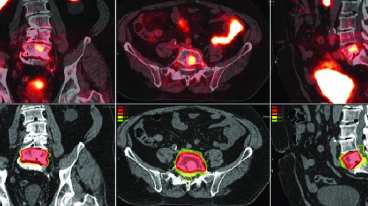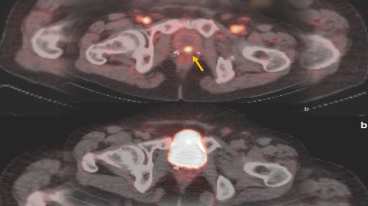PSMA PET scan in Prostate Cancer: What, When, Why - Current Perspective and Future Trends
Introduction to PSMA Pet Scan and Prostate Cancer
Prostate cancer is one of the most common cancers affecting men worldwide. Early detection and accurate staging are crucial for effective management and treatment. Among the various diagnostic tools available, PSMA PET Scan (Prostate-Specific Membrane Antigen Positron Emission Tomography) has emerged as a revolutionary imaging method for prostate cancer, impacting its diagnostic accuracy and treatment efficacy. This comprehensive guide on PSMA PET scan for prostate cancer delves into what PSMA PET/CT is, when and why it is used, its current perspective, and future trends in the field of prostate cancer.

What is PSMA PET/CT?
What is PSMA?
Prostate-Specific Membrane Antigen (PSMA) is a cell surface protein highly expressed in prostate cancer cells. It is an excellent target for imaging and therapy because it is present in high amounts in prostate cancer tissues and has limited expression in normal tissues. This specificity makes PSMA an ideal marker for detecting prostate cancer.

What is PET-CT Scan?
PET/CT combines the functional imaging of PET scan with the anatomical detail of CT scan for prostate cancer. In the context of PSMA PET/CT, a radiotracer (commonly 68Ga-PSMA-11 or 18F-DCFPyL) is injected into the patient. This radiotracer binds to PSMA-expressing cells, allowing for the detection of prostate cancer through PET imaging. The CT scan provides detailed images of the body's internal structures, helping to pinpoint the exact location of cancerous lesions.

When is PSMA PET/CT Used in Prostate Cancer?
Initial Diagnosis of Prostate Cancer
PSMA PET/CT is increasingly used in all stages of prostate cancer:
High risk prostate cancer : In initial diagnosis of prostate cancer, particularly in patients with high-risk disease, It can detect cancerous lesions outside the prostate that might not be visible with conventional imaging techniques such as bone scans, CT scans, or MRIs.
Early Stage prostate cancer : In early stage prostate cancer diagnosis, when conventional imaging techniques can miss small sized cancer tissue, PSMA can help in detecting small prostate cancer lesions by lighting them up in PET scan.
Staging of Prostate Cancer
Staging is crucial in determining the extent of prostate cancer spread and planning treatment. PSMA PET/CT is highly effective in staging prostate cancer by identifying both local and distant metastases, providing a comprehensive overview of the disease.
Recurrence of Prostate Cancer
PSMA PET/CT is invaluable in detecting biochemical recurrence, where prostate-specific antigen (PSA) levels rise after initial treatment, indicating the possible return of cancer at an earlier stage. It can locate recurrent disease with high sensitivity and specificity, even at low PSA levels, thereby helping in early treatment of prostate cancer recurrence.
Treatment Planning and Monitoring
For patients undergoing treatment, PSMA PET/CT helps in treatment planning by accurately delineating tumor extent and guiding targeted therapies. It is also used to monitor response to treatment, helping to assess the effectiveness of therapeutic interventions.
Why is PSMA PET/CT Important?
Enhanced Sensitivity and Specificity
PSMA PET/CT offers superior sensitivity and specificity compared to conventional imaging modalities like MRI or CT for prostate cancer. It can detect small lesions and early metastatic disease that might be missed by other techniques.
Improved Patient Outcomes
Accurate staging and early detection of recurrent disease enable tailored treatment approaches, improving patient outcomes. By providing detailed information about the location and extent of cancer, PSMA PET/CT helps in making informed decisions about the most appropriate therapeutic strategies.
Reduced Need for Invasive Procedures
PSMA PET/CT can reduce the need for invasive procedures like biopsies by providing precise imaging of cancerous tissues. This non-invasive approach minimizes patient discomfort and associated risks.
Comprehensive Disease Assessment
PSMA PET/CT allows for a comprehensive assessment of prostate cancer, from initial diagnosis through to monitoring treatment response and detecting recurrence. This holistic view of the disease is crucial for effective management and long-term patient care.
Current Perspective on PSMA PET/CT in Prostate Cancer
Clinical Use
PSMA PET/CT has gained significant traction in clinical practice of prostate cancer by various urologist and urooncologist, with numerous studies validating its efficacy in prostate cancer imaging. It is now widely used in many cancer centres around the world, particularly for high-risk and recurrent prostate cancer cases.
Guidelines and Recommendations
Professional organizations, including the American Society of Clinical Oncology (ASCO) and the European Association of Urology (EAU), have incorporated PSMA PET/CT into their guidelines for prostate cancer management. These recommendations reflect the growing recognition of the modality's value in clinical practice.
Comparative Studies
Comparative studies have demonstrated that PSMA PET/CT outperforms traditional imaging techniques like MRI and Bone scan in detecting prostate cancer metastases. Research has shown that it can identify metastatic lesions with greater accuracy, leading to better staging and treatment planning.
Limitations and Challenges
Despite its advantages, PSMA PET/CT has some limitations. Availability and cost can be barriers to widespread adoption, and not all healthcare facilities have the necessary infrastructure. Additionally, false-positive results can occur, particularly in tissues with benign conditions that express PSMA.
Future Trends in PSMA PET/CT for Prostate Cancer
Advancements in Radiotracers
Research is ongoing to develop new and improved radiotracers for PSMA PET/CT. These advancements aim to enhance imaging quality, increase specificity, and reduce potential side effects. Radiotracers like 18F-DCFPyL are already showing promise in providing clearer images and longer half-lives compared to earlier tracers.
Integration with Other Imaging Modalities
Future trends include integrating PSMA PET/CT with other advanced imaging modalities, such as MRI, to provide even more detailed and comprehensive assessments of prostate cancer. Hybrid imaging techniques could further enhance diagnostic accuracy and treatment planning.
Personalized Medicine
As personalized medicine continues to evolve, PSMA PET/CT will play a crucial role in tailoring treatments to individual patients. By providing precise information about tumor characteristics and extent, this imaging modality will help in designing personalized therapeutic strategies that maximize efficacy and minimize side effects.
Theranostics
The concept of theranostics, combining therapeutic and diagnostic capabilities, is gaining momentum in prostate cancer care. PSMA-targeted radioligand therapy (PRLT), which uses PSMA PET/CT for imaging and delivers targeted radiation to cancer cells, is a promising approach. This dual-functionality approach could revolutionize prostate cancer treatment by allowing simultaneous diagnosis and therapy.
Artificial Intelligence and Machine Learning
Artificial intelligence (AI) and machine learning are poised to enhance PSMA PET/CT imaging for prostate cancer by improving image analysis and interpretation. AI algorithms can assist in detecting subtle changes, quantifying prostate cancer burden, and predicting treatment responses, making PSMA PET/CT even more powerful and efficient.
Expansion of Clinical Applications
The applications of PSMA PET/CT are expected to expand beyond prostate cancer. Research is exploring its potential in other cancers that express PSMA, such as renal cell carcinoma and certain types of breast cancer. This broader application could make PSMA PET/CT a valuable tool in the diagnosis and management of various malignancies.
Global Access and Standardization
Efforts are underway to increase global access to PSMA PET/CT by reducing costs and improving infrastructure. Standardization of imaging protocols and reporting criteria will also be crucial in ensuring consistent and reliable use of this technology worldwide.
Conclusion
PSMA PET/CT has revolutionized the landscape of prostate cancer diagnosis, staging, and management. Its ability to provide detailed and accurate imaging of prostate cancer makes it an invaluable tool in the fight against this prevalent disease. As advancements continue and its clinical applications expand, PSMA PET/CT will play an increasingly vital role in improving patient outcomes and advancing the field of urooncology.
If you or a loved one is facing prostate cancer, discussing the option of PSMA PET/CT with your urologist oncologist could be a critical step in your treatment journey. Early and accurate detection, combined with personalized treatment strategies, can significantly enhance the chances of successful outcomes and improved quality of life.
By delving deep into the capabilities and future prospects of PSMA PET/CT, this blog post aims to provide a thorough understanding of this cutting-edge technology. As a key player in the diagnosis and management of prostate cancer, PSMA PET/CT is poised to continue transforming the field and improving patient outcomes.

